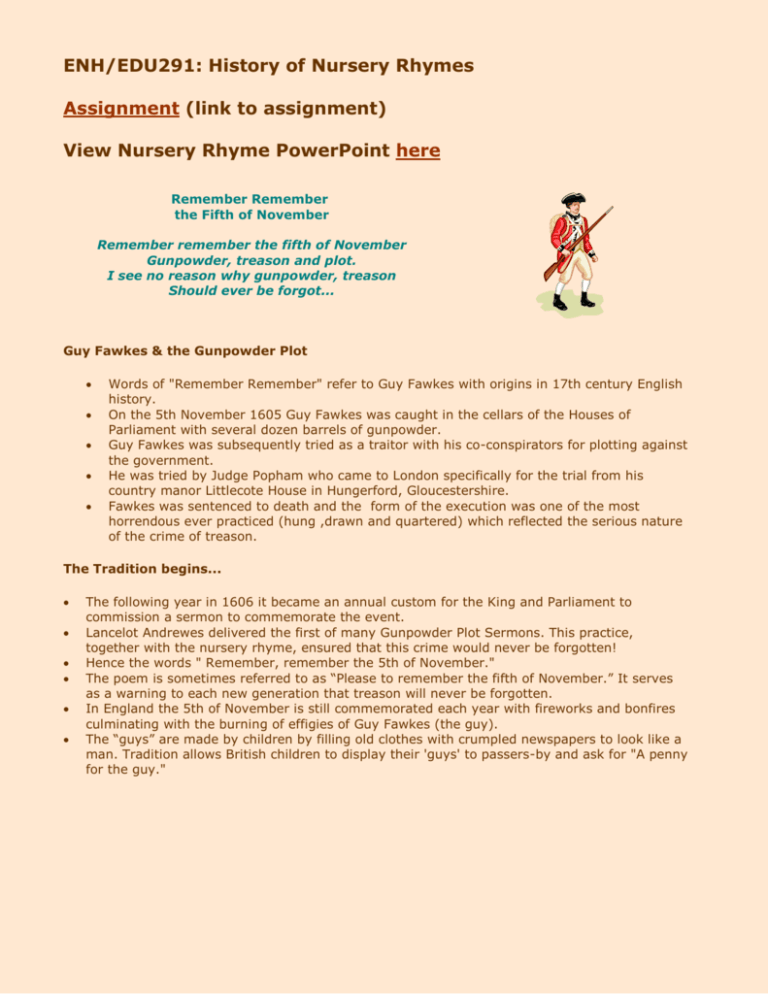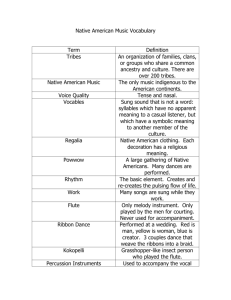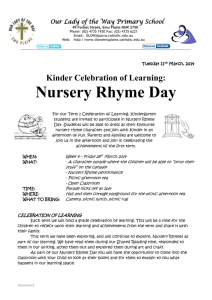ENH/EDU291: History of Nursery Rhymes
advertisement

ENH/EDU291: History of Nursery Rhymes Assignment (link to assignment) View Nursery Rhyme PowerPoint here Remember Remember the Fifth of November Remember remember the fifth of November Gunpowder, treason and plot. I see no reason why gunpowder, treason Should ever be forgot... Guy Fawkes & the Gunpowder Plot Words of "Remember Remember" refer to Guy Fawkes with origins in 17th century English history. On the 5th November 1605 Guy Fawkes was caught in the cellars of the Houses of Parliament with several dozen barrels of gunpowder. Guy Fawkes was subsequently tried as a traitor with his co-conspirators for plotting against the government. He was tried by Judge Popham who came to London specifically for the trial from his country manor Littlecote House in Hungerford, Gloucestershire. Fawkes was sentenced to death and the form of the execution was one of the most horrendous ever practiced (hung ,drawn and quartered) which reflected the serious nature of the crime of treason. The Tradition begins... The following year in 1606 it became an annual custom for the King and Parliament to commission a sermon to commemorate the event. Lancelot Andrewes delivered the first of many Gunpowder Plot Sermons. This practice, together with the nursery rhyme, ensured that this crime would never be forgotten! Hence the words " Remember, remember the 5th of November." The poem is sometimes referred to as “Please to remember the fifth of November.” It serves as a warning to each new generation that treason will never be forgotten. In England the 5th of November is still commemorated each year with fireworks and bonfires culminating with the burning of effigies of Guy Fawkes (the guy). The “guys” are made by children by filling old clothes with crumpled newspapers to look like a man. Tradition allows British children to display their 'guys' to passers-by and ask for "A penny for the guy." The picture is of the 'Gunpowder Plot' conspirators. Starting with Thomas Bates, Robert Wintour, Christopher Wright, Wright, John Wright, Thomas Percy, Guy Fawkes, Robert Catesby and Thomas Wintour Ring a Ring o Rosies Ring around the rosy A pocketful of posies "Ashes, Ashes" We all fall down! Ring-a-Ring o'Rosies A Pocket full of Posies "A-tishoo! A-tishoo!" We all fall Down! Connections to the Bubonic Plague (Black Death)? The words to the Ring around the rosy children's ring game have their origin in English history. The historical period dates back to the Great Plague of London in 1665 (bubonic plague) or even before when the first outbreak of the Plague hit England in the 1300's. The symptoms of the plague included a rosy red rash in the shape of a ring on the skin (Ring around the rosy). Pockets and pouches were filled with sweet smelling herbs (or posies) which were carried due to the belief that the disease was transmitted by bad smells. The term "Ashes Ashes" refers to the cremation of the dead bodies! The death rate was over 60% and the plague was only halted by the Great Fire of London in 1666 which killed the rats which carried the disease which was transmitting via water sources. The English version of "Ring around the rosy" replaces Ashes with (A-tishoo, A-tishoo) as violent sneezing was another symptom of the disease. Views of the Sceptics The connection between this rhyme was made by James Leasor in 1961 in his non-fiction book ' The Plague and the Fire. Some people are sceptical of the plague interpretations of this rhyme, many stating that words in the rhyme cannot be found in Middle English. The sceptics must be referring to the later version of the rhyme, possibly with American origins, the English version is "Ring a ring o' rosies" using the Middle English "o" as a shortening of the word "of." The written word " posies" is first mentioned in a poem called 'Prothalamion or A Spousal Verse' by Edmund Spenser (1552-1599). We believe that this addresses the views of the sceptics. Picture of a Plague Physician of the 17th Century London Bridge Is Falling Down London Bridge is falling down, Falling down, falling down, London Bridge is falling down, My fair Lady. Iron and steel will bend and bow, Bend and bow, bend and bow, Iron and steel will bend and bow, My fair Lady. Build it up with wood and clay, Wood and clay, wood and clay, Build it up with wood and clay, My fair Lady. Build it up with silver and gold, Silver and gold, silver and gold, Build it up with silver and gold, My fair Lady. Wood and clay will wash away, Wash away, wash away, Wood and clay will wash away, My fair Lady. Silver and gold will be stolen away, Stolen away, stolen away, Silver and gold will be stolen away, My fair Lady. Build it up with bricks and mortar, bricks and mortar, bricks and mortar . . . Set a man to watch all nigh, Watch all night, watch all night, Bricks and mortar will not stay, Will not stay, will not stay . . . Suppose the man should fall asleep, Fall asleep, fall asleep, Build it up with iron and steel, Iron and steel, iron and steel, Give him a pipe to smoke all night, Smoke all night, smoke all night, The Wooden Bridge The 'London Bridge is falling down' Nursery Rhyme is based on the one of the most famous landmarks in London. Its history can be traced to the Roman occupation of England in the first century. The first London Bridge was made of wood and clay and was fortified or re-built with the various materials mentioned in the children's nursery rhyme. Many disasters struck the bridges - Viking invaders destroyed the bridge in the 1000's which led to a fortified design, complete with a drawbridge. Building materials changed due to the many fires that broke out on the bridge. The Stone Bridge The first stone bridge was designed by Peter de Colechurch. Built in 1176 and took 33 years to build featured twenty arches the dimensions of which were sixty feet high and thirty feet wide complete with tower and gates. The flow of the Thames under the bridge was used to turn water wheels below the arches for grinding grain. By the 1300's the bridge contained 140 shops, some of which were more than three stories high. The reference to Silver and Gold in the rhyme relates to the trading which was conducted on the bridge. London Bridge survived the Great Fire of London in 1666 but its arches and foundations were weakened. Buildings with thatched roofs were banned in London following the Great Fire of 1666 and this ban was only lifted with the construction of the New Globe Theater in 1994. The Modern Re-builds! In the 1820s a new London Bridge was built on another site, north of the old one. This new bridge opened in 1831 and the old bridge was demolished. In the 1960s yet another London Bridge was built. The London Bridge of 1831 was transported, stone by stone, to Lake Havasu in Arizona, USA. NB There is another Nursery Rhyme called 'London bridge is broken down' - its origins relate to Queen Anne Boleyn - fascinating! And for other surprising revelations about Executions, Torturers and Lord Mayors check out London Bells a Nursery Rhyme containing the original lyrics to Oranges and Lemons! A Picture of London Bridge, complete with houses, gatehouse and church London Bridge Is Broken Down Nursery Rhyme London bridge is broken down, Dance over my Lady Lee, London bridge is broken down, With a gay ladye. How shall we build it up again? Dance over my Lady Lee, How shall we build it up again? With a gay ladye. Who was Lady Lee? The origins of this nursery rhyme are truly fascinating and have roots in the extraordinary events surrounding King Henry VIII of England (1491–1547) and his second, tragic, wife Anne Boleyn. The 'Lady Lee' referred to in the Nursery Rhyme was, in fact, Lady Margaret Wyatt, the sister of Thomas Wyatt the poet. She married Sir Anthony Lee of Quarrendon and thus became Lady Lee. The Wyatts were neighbors of the Boleyn family and Anne and Margaret were childhood friends. Anne Boleyn As Anne rose in power Margaret accompanied her and become a trusted lady-in-waiting. When Anne was accused of bigamy Thomas Wyatt was accused with her, but he was later released. Margaret, Lady Lee, stayed with Anne Boleyn until her execution and attended the ill-fated queen on the scaffold. The nursery rhyme London Bridge Is Broken Down can be described as an allegory - a description of one thing under the image of another. The words of the nursery rhyme are believed to describe the rise and fall of Anne Boleyn (the gay ladye) and the lyrics use the name of Lady Lee to clearly identify the central character, Anne Boleyn. The Hidden Secrets in Nursery Rhymes Many nursery rhymes have secret, hidden, meanings and allude to people and events in history. Anne Boleyn was hated by the common people of England, due to her haughty manner and the common folk's strong allegiance to Henry VIII's first wife, Katherine of Aragon. Open criticism of Anne was approved and encouraged during the reigns of Henry VIII and his eldest daughter Mary (Bloody Mary - Henry and Katherine's daughter). But when Queen Elizabeth I ascended to the throne all such approval and criticism stopped the new Queen was the daughter of Henry VIII and Anne Boleyn. The words and lyrics of London Bridge Is Broken Down are thus explained. King Henry VIII and Anne Boleyn London Bells Oranges and Lemons Gay go up and gay go down To Ring the Bells of London Town "Oranges and Lemons" say the Bells of St. Clements "Bullseyes and Targets" say the Bells of St. Margaret's "Brickbats and Tiles" say the Bells of St. Giles "Oranges and lemons" say the Bells of St. Clement's "You owe me five farthings" say the Bells of St. Martin's "Halfpence and Farthings" say the Bells of St. Martin's "Pancakes and Fritters" say the Bells of St. Peter's "Two Sticks and an Apple" say the Bells of Whitechapel "Maids in white aprons" say the Bells at St. Katherine's "Pokers and Tongs" say the Bells of St. John's "Kettles and Pans" say the Bells of St. Anne's "Old Father Baldpate" say the slow Bells of Aldgate "You owe me Ten Shillings" say the Bells of St. Helen's "When will you Pay me?" say the Bells of Old Bailey "When I grow Rich" say the Bells of Shoreditch "Pray when will that be?" say the Bells of Stepney "I do not know" say the Great Bell of Bow Gay go up and gay go down To Ring the Bells of London Town "When will you pay me?" say the Bells of Old Bailey "When I grow rich" say the Bells of Shoreditch "When will that be?" say the Bells of Stepney "I do not know" say the Great Bells of Bow "Here comes a Candle to light you to Bed Here comes a Chopper to Chop off your Head Chip chop chip chop - the Last Man's Dead." The origin of the words to "Oranges and lemons" - strange & sinister! The exact date of origin is unknown but there was a Square Dance called Oranges and Lemons dating back to 1665, unfortunately there are no known record of the lyrics which accompanied the dance but is likely that the words were similar to that of the nursery rhyme. The words to Oranges and Lemons have been much loved by numerous generations of children. The neighborhood names relate to some of the many churches of London and the tune that accompanies the lyrics emulates the sound of the ringing of the individual church bells. The Tyburn Gallows The words of the nursery rhyme are chanted by children as they play the game of 'Oranges and lemons' the end of which culminates in a child being caught between the joined arms of two others, emulating the act of chopping off their head! The reason for the sinister last three lines of the lyrics of Oranges and Lemons is easily explained; they were added to the original rhyme, probably by children! This addition dates to some time before 1783 when the infamous public execution gallows (the Tyburn-tree) was moved from Tyburn-gate (Marble Arch) to Newgate, a notorious prison for both criminals and debtors hence "When will you pay me? " This move was necessary to reduce problems caused by the crowds, often exceeding 100,000, gathered along the execution procession route. This stretched along a three mile route from Newgate Prison to Tyburn and around the Tyburn tree itself. Newgate Prison The “Bells of Old Bailey,” or more accurately the tenor bell of St Sepulchre, had been utilized prior to 1783 to time the executions, but after the gallows had been moved, Newgate prison (now the site of the Old Bailey) obtained its own bell. As the words to the poem Oranges and Lemons indicate the unfortunate victim would await execution on “Death Row.” The prisoner would be informed by the Bellman of St. Sepulchre by candle light “here comes the candle to light you to bed,” at midnight outside their cell , the Sunday night prior to their imminent fate, by the ringing of the “Execution Bell” (a large hand bell) and the recitation of the following : All you that in the condemned hole do lie, Prepare you for tomorrow you shall die; Watch all and pray: the hour is drawing near That you before the Almighty must appear; Examine well yourselves in time repent, That you may not to eternal flames be sent. And when St. Sepulchre's Bell in the morning tolls The Lord above have mercy on your soul. The executions commenced at nine o'clock Monday morning following the first toll of the tenor bell. Who would have thought that Oranges and Lemons, a children’s rhyme could have such a sinister historical connotation? Execution Procession at Tyburn, London Origin of the saying "On the Wagon" - meaning a person has stopped drinking alcohol! Prisoners were transported to Tyburn Gallows on a wagon and were allowed one last drink in a pub on the way to their execution. If offered a second drink by a sympathizer the guard would reply, "No, they're going on the Wagon!" The Bells of London Nursery Rhyme evolves into Oranges and Lemons! The Oranges and Lemons Nursery Rhymes refer to many of the Churches and Institutions found near, or within the City of London. The alternative lyrics to Oranges and Lemons rhyme is the London Bells Nursery Rhyme which is the original version of Oranges and Lemons. The Children's Choice! Over the course of time the original lyrics have been forgotten - the cut-down version is much easier for children to remember. The section at the end of the Oranges and Lemons rhyme "Here comes the candle..." was added at a much later date, enabling children to play the party game. Our Heritage Is Conveyed in Nursery Rhymes! The words of the London Bells rhyme accurately reflect the history of London and maintain our heritage - the traditions and customs practiced in London's bygone days. The Bells of London Are Telling Us Stories! The stories relating to the Bells of London reflect the history of the city and the people who lived there. At first glance the 'Bells of London' and the newer version of 'Oranges and Lemons' Nursery Rhymes look to be interesting poems which include the most famous bells and churches of London. But the rhyme is actually very clever for the words the bells are saying, such as "Oranges and Lemons," "Bullseyes and Targets" and "Pokers and Tongs," reveal the many long-gone trades practiced and wares sold by the people who lived in the great city of London. They also reveal the history of life in London! Lord Mayors, Torturers, Executioners and Money Lenders! Lord Mayors, Torturers, Executioners and Money Lenders are all referred to in the words of the bells! The secret history and origins of the Bells of London Nursery Rhyme are revealed - once again a seemingly innocent Nursery Rhyme for children hides sinister undertones! Tower of London "Bells of St Johns" in St John's Chapel in the White Tower http://www.rhymes.org.uk/london-bridge-is-falling-down.htm http://www.rhymes.org.uk/ The gruesome practice of execution by beheading is revealed in Jack and Jill. Assignment (link to assignment)








